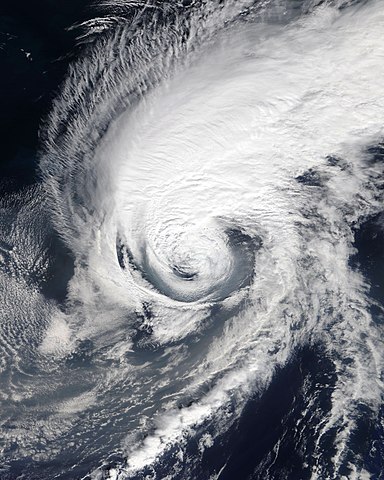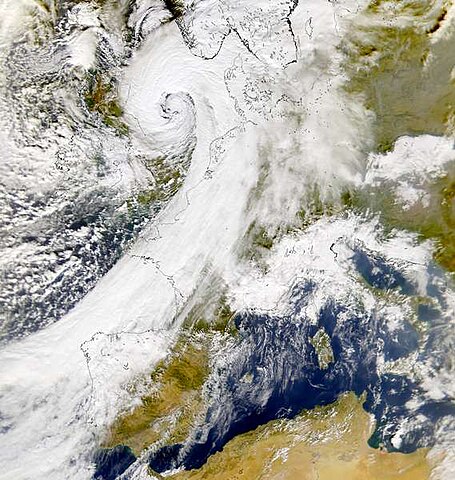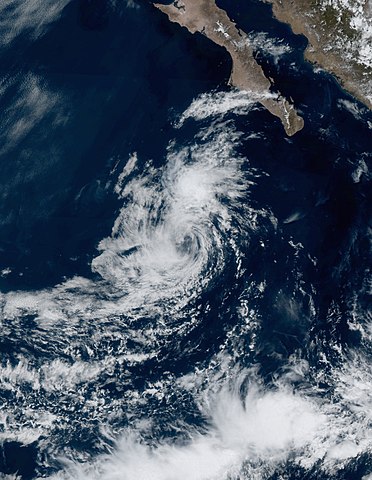The world of meteorology is filled with complex and fascinating weather phenomena, and one of the most intriguing is the post-tropical cyclone. In this article, we’ll give the post-tropical cyclone definition as well as explore their formation, characteristics, and impacts.
How a Tropical Cyclone Becomes Post-Tropical
Tropical cyclones, often referred to as hurricanes or typhoons depending on their location, originate over warm ocean waters. These storms thrive on the energy derived from the heat and moisture present in these tropical regions. Their tightly organized structure and the presence of an eye make them formidable weather systems.
As a tropical storm moves away from its tropical birthplace, it encounters cooler sea surface temperatures and a more stable atmospheric environment. This sets the stage for a critical transformation known as extratropical transition. During this process, the storm gradually loses its tropical characteristics.For instance, in September 2020, Hurricane Paulette became an extratropical cyclone, when it moved to colder regions over Nova Scotia and beyond.
 Source: Wikipedia
Source: Wikipedia
After the tropical cyclone has fully completed its transition into an extratropical cyclone, it is classified as a post-tropical cyclone. At this point, it is no longer considered a tropical cyclone and may no longer be officially named as such. However, it can still be a powerful weather system capable of producing strong winds, heavy rainfall, and other severe weather conditions.
Post-Tropical Cyclone Types
There are two main types of post-tropical cyclones: extratropical cyclones and remnant lows.
Extratropical Cyclone
Here are some things to know about extratropical cyclones:
- How they form. Extratropical cyclones typically form where different air masses meet - specifically, at weather fronts. When warm, wet air meets cold, dry air, it makes the air unstable and can lead to cyclone formation.
- Comma shape. Extratropical cyclones often have clouds that look like commas. The head of the comma, where the low-pressure area is, typically has heavy precipitation. The tail of the comma has a gap of dry air on its west side.
 Source: Wikipedia
Source: Wikipedia
Weather effects. Extratropical cyclones can cause many kinds of weather, like rain, snow, strong winds, and temperature changes. They can also lead to severe weather storms, tornadoes, and blizzards, depending on the season and the atmospheric conditions.
- Direction. These cyclones typically move from west to east across the middle parts of Earth, pushed by the winds that blow in these areas. Their paths can change, and they can sometimes stop or wander, making the weather unsettled for a long time.
- Duration. Extratropical cyclones can last for several days. Their lifespan can change depending on many factors, like their size and the air conditions around them.
Remnant Low
The remnant low is a term used in meteorology to describe the weakened and disorganized remnants of what was once a tropical cyclone or hurricane. When a tropical storm loses its warm, wet air and meets worse air conditions, it gets weaker and changes into another weather system. This change can result in the formation of a remnant low.
 Source: Wikipedia
Source: Wikipedia
Here are some key characteristics and features of remnant lows:
- Weaker structure. Moving over cooler water, stronger wind shear, or land makes the tropical cyclone lose its structure. It no longer has a clear eye and organized storms.
- Loss of warm core. Tropical storms have a warm core, where the warm, wet air in the middle of the storm is an important energy source. As the storm gets weaker and moves into worse conditions, it loses this warm core.
- Lower wind speeds. While a hurricane or typhoon can have sustained winds over 74 mph (119 km/h), the wind speeds in a remnant low are typically much weaker.
- Less organized precipitation. The heavy rain and thunderstorms that come with a tropical cyclone become more spread out and less organized as the cyclone gets weaker. This can still cause rainfall and the chance for flooding in some places. However, it does not have the organized rainfall bands of a stronger tropical cyclone.
- Forecasting challenges. Weather forecasting for post-tropical cyclones, including remnant lows, can pose challenges for meteorologists. This is because cyclone behavior becomes less predictable as it weakens and loses its tropical characteristics. It may move around, change direction, or go away completely.
Conclusion
Now let’s summarize the key differences between a tropical storm vs. post-tropical cyclone:
| Tropical | Post-Tropical |
|---|---|
| Is symmetrical, has a well-defined center called an eye | Has a less symmetrical structure |
| Gets all of its energy from the warm sea surface temperatures | Relies on the temperature differences in the atmosphere |
| Concentrated heavy rainfall near the center | Evenly distributed precipitation |
In the world of meteorology, the evolution of a tropical cyclone into a post-tropical cyclone is a captivating process. While the terminology may be complex, the message is clear: these storms, though changed in nature, can still pose significant threats to the regions they affect. Understanding the post-tropical cyclone development and impact can help communities prepare for the challenges these cyclones bring.






